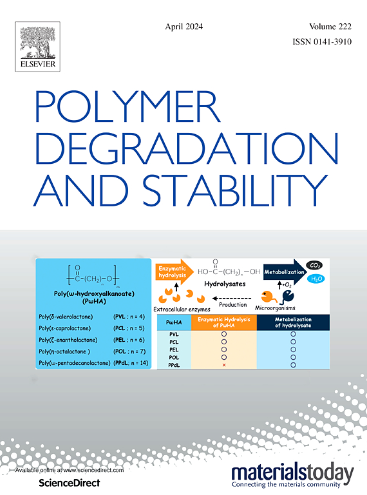增强机械性能的耐用阻燃再生纤维素纤维的制备
IF 7.4
2区 化学
Q1 POLYMER SCIENCE
引用次数: 0
摘要
在再生纤维素纺丝液中掺入阻燃剂是生产阻燃再生纤维素纤维的重要途径。然而,这种方法经常遇到诸如阻燃剂在基体内相容性差和分散不充分等挑战。本研究以硫酸四甲基磷、亚磷酸二甲酯和氨溶液为原料合成了一种新型阻燃剂P-TSDPAH。P-TSDPAH含有大量的- nh -键,与纤维素和n -甲基morpholine N-oxide (NMMO)具有相容性,在纤维素纺丝溶液中保持良好的分散性。SEM分析显示P-TSDPAH均匀分布在fr纤维内15%,没有聚集,EDS结果证实了大量磷的存在。FTIR分析证实在15%的fr纤维中存在特征的P-C-O、CN和NH结构。XRD分析显示,掺入P-TSDPAH后,fr纤维的结晶度提高了15%。与纯再生纤维素纤维相比,15% fr纤维的峰值放热率和总放热率分别降低了88.61%和30.50%,而700℃下的炭渣则增加了142.79%。TG和TG- ir分析表明,fr纤维的阻燃性为15%,揭示了凝聚相阻燃机理,而极限氧指数(LOI)即使在50次洗涤循环后仍保持在35.0% (NFPA 2112-2012标准),显示出持久的性能。P-TSDPAH的掺入提高了再生纤维素纤维的力学性能,其相对断裂强度和伸长率分别提高了31.16%和48.05%。因此,合成的P-TSDPAH在开发耐用阻燃再生纤维素纤维方面具有应用潜力。本文章由计算机程序翻译,如有差异,请以英文原文为准。
Preparation of a durable flame-retardant regenerated cellulose fiber with enhanced mechanical properties
The incorporation of flame retardants into regenerated cellulose spinning solutions is a crucial approach for producing flame-retardant regenerated cellulose fibers. However, this method often encounters challenges such as poor compatibility and inadequate dispersion of the flame retardants within the matrix. In this study, a novel flame retardant (P-TSDPAH) was synthesized using ordinary materials such as tetramethylphosphonium sulfate, dimethyl phosphite, and ammonia solution. The P-TSDPAH contains a lot of -NH- bonds, exhibits compatibility with cellulose and N-methylmorpholine N-oxide (NMMO), and remains good dispersion in the cellulose spinning solution. SEM analysis revealed that the P-TSDPAH was uniformly distributed within the FR-fiber 15 % without aggregation, and EDS results confirmed the presence of substantial phosphorus content. FTIR analysis confirmed the presence of characteristic P-C-O, C![]() N, and N
N, and N![]() H structures within the FR-fiber 15 %. XRD analysis revealed an enhanced crystallinity in the FR-fiber 15 % upon incorporation of the P-TSDPAH. Compared with pure regenerated cellulose fibers, the peak heat release rate and total heat release of FR-fiber 15 % were reduced by 88.61 % and 30.50 %, respectively, while the char residue at 700 °C increased by 142.79 %. TG and TG-IR analyses demonstrated the flame retardancy of the FR-fiber 15 %, revealing condensed-phase flame retardant mechanism, while limiting oxygen index (LOI) remained at 35.0 % even after 50 washing cycles (NFPA 2112–2012 standard), demonstrating durable performance. Additionally, the incorporation of the P-TSDPAH enhanced the mechanical properties of the regenerated cellulose fibers, which the relative breaking strength and elongation increased by 31.16 % and 48.05 %, respectively. Therefore, the synthesized P-TSDPAH demonstrates application potential for developing durable flame-retardant regenerated cellulose fibers.
H structures within the FR-fiber 15 %. XRD analysis revealed an enhanced crystallinity in the FR-fiber 15 % upon incorporation of the P-TSDPAH. Compared with pure regenerated cellulose fibers, the peak heat release rate and total heat release of FR-fiber 15 % were reduced by 88.61 % and 30.50 %, respectively, while the char residue at 700 °C increased by 142.79 %. TG and TG-IR analyses demonstrated the flame retardancy of the FR-fiber 15 %, revealing condensed-phase flame retardant mechanism, while limiting oxygen index (LOI) remained at 35.0 % even after 50 washing cycles (NFPA 2112–2012 standard), demonstrating durable performance. Additionally, the incorporation of the P-TSDPAH enhanced the mechanical properties of the regenerated cellulose fibers, which the relative breaking strength and elongation increased by 31.16 % and 48.05 %, respectively. Therefore, the synthesized P-TSDPAH demonstrates application potential for developing durable flame-retardant regenerated cellulose fibers.
求助全文
通过发布文献求助,成功后即可免费获取论文全文。
去求助
来源期刊

Polymer Degradation and Stability
化学-高分子科学
CiteScore
10.10
自引率
10.20%
发文量
325
审稿时长
23 days
期刊介绍:
Polymer Degradation and Stability deals with the degradation reactions and their control which are a major preoccupation of practitioners of the many and diverse aspects of modern polymer technology.
Deteriorative reactions occur during processing, when polymers are subjected to heat, oxygen and mechanical stress, and during the useful life of the materials when oxygen and sunlight are the most important degradative agencies. In more specialised applications, degradation may be induced by high energy radiation, ozone, atmospheric pollutants, mechanical stress, biological action, hydrolysis and many other influences. The mechanisms of these reactions and stabilisation processes must be understood if the technology and application of polymers are to continue to advance. The reporting of investigations of this kind is therefore a major function of this journal.
However there are also new developments in polymer technology in which degradation processes find positive applications. For example, photodegradable plastics are now available, the recycling of polymeric products will become increasingly important, degradation and combustion studies are involved in the definition of the fire hazards which are associated with polymeric materials and the microelectronics industry is vitally dependent upon polymer degradation in the manufacture of its circuitry. Polymer properties may also be improved by processes like curing and grafting, the chemistry of which can be closely related to that which causes physical deterioration in other circumstances.
 求助内容:
求助内容: 应助结果提醒方式:
应助结果提醒方式:


